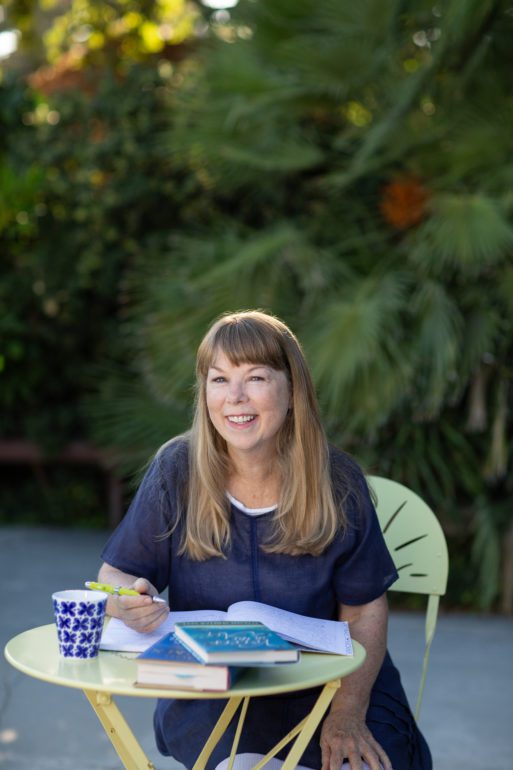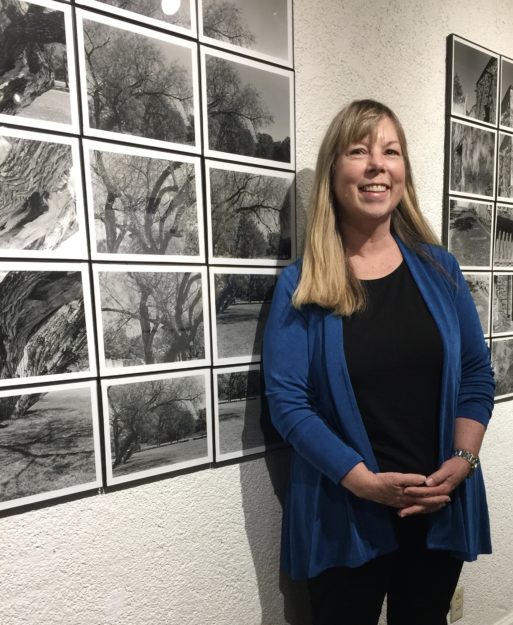
Tegner recommends journal writing in addition to reading and writing poetry.
Ingrid Tegner has been offering poetry therapy, or training and mentoring poetry facilitators, for several decades. After completing a two-year training at St. Elizabeths Hospital in Washington, D.C. and obtaining a Master of Social Work from the University of Maryland, Baltimore, she worked for about seven years with an organization called Life With Cancer, where she used poetry to help patients develop coping skills and resilience. In 2009, she co-authored a paper finding that participants display improved resilience, measured in part by reduced suppression of anger and lower levels of anxiety. These days, Tegner, who is based in California, trains facilitators to lead poetry groups enabling participants to navigate hidden sentiments, unexpressed emotions and other unexplored aspects of major life challenges.
In addition to her love of poetry, Tegner is an accomplished artist whose work includes installations, photography, handmade paper and encaustic. “My work focuses on memory, history and narrative illustrating how we are all connected to one another,” her artist statement declares.
For Tegner, poetry is yet another art form that enables her to connect people to each other, and – despite the most challenging of circumstances – to themselves.
What first drew you to poetry, and who are some of your favorite poets?
One of the things I like about poetry is that it’s always available. You can find it in books, you can find it online. You can keep a poem in your pocket. Some of my favorite poets are Mary Oliver, Naomi Shihab Nye, William Stafford, Linda Pastan, Wendell Berry, and Stanley Kunitz – there are just so many.
There’s a certain criteria when choosing a poem. If you have a group that’s going to meet for a certain amount of time, you’ll start with poems about getting to know one another, and discussing things that you can guess everybody has in common. They’ll be poems that have a positive or hopeful aspect. They’re not trite, they’re not Hallmark cards. There will also be shadows and places where it’s ambiguous. Metaphor is really important. These poems usually fit on one page. And you would choose something that everyone in your group can understand with the first reading. You never want anybody to think that they have to go to the dictionary because a lot of people are afraid of poetry. They’ve had bad experiences in school, they think that they don’t “get it.” Sometimes I call my groups writing groups rather than poetry groups because people think they can’t write poetry.

Tegner works on an encaustic panel
How did you become interested in poetry as a therapeutic tool?
I was going back to work after having my kids and found out that there was something called poetry therapy. I lived in Maryland, and there turned out to be a really vibrant poetry therapy community in the Washington, D.C. area. So I started going to their events and joined the training program at St. Elizabeths Hospital. At first, I just wanted to work more with poems, but after doing the two-year training, I decided that I’d like to do this seriously – that this could be a job. So that led me to social work school.
What kind of training did you receive to become a poetry therapist?
The field of poetry therapy has been around for more than 40 years, and people still haven’t heard about it. The training program at St. Elizabeths started in 1974 but is no longer running. The education was didactic – we had several textbooks. There was also a part where we learned how to facilitate. I’ve been doing this since the ‘90s, and I still prepare for the groups that I do. I write questions that I might ask, based on the group that I’m meeting with. You always have a goal – it might be simple, like dealing with life issues, or it could be something more complex.
You also get supervision. For that part of the training, I went out and worked with kids that were in special schools. And then there’s the peer group, where you take turns leading. Sometimes a poem you imagined would be really great for the group gets a very different response.
At the time I was training, there were only certified poetry therapists and registered poetry therapists. States have since introduced new laws, and you have to be licensed as a therapist in order to call yourself a poetry therapist. Because I gave up my license when I moved to California, my title is now “certified applied poetry facilitator.” We have our own code of ethics.
What does the process look like when you’re using poetry as a therapeutic tool with cancer patients?
There’s an organization called Life With Cancer, and they were the sponsor for a study we did on the effect of poetry on cancer patients. Life With Cancer offers all kinds of opportunities for people in treatment or after treatment, including reiki, art therapy, music therapy and yoga, so I was part of their offerings.
I ran a group called Writing to Wellness for about seven years. The sessions focused on a poem and began with a warm-up. One of the poems that I used was “In Blackwater Woods,” by Mary Oliver, and my warm-up for that was to bring cinnamon. I had everyone take a little sniff and then talk about what memory arose. Generally, cinnamon brings forth baking and family and holidays. If I could bring all of the senses into a session I would.
Then the poem is read. I often ask group members to read it two or three times, because everybody will read it a little bit differently, and a poem is generally so dense with the images that you have to hear it more than once. Often on the third time, some things hit you somewhere in your body – there’s a feeling response. My questions are generally feeling questions. I would never say, “What did you think of that?” You’d go right into your head and then you’re inviting people to critique Mary Oliver, and that’s the wrong direction. So I ask questions such as, “What’s still resonating with you?” Or, “What lines seemed to be most important to you?” That starts the discussion, and then the group takes on the conversation. When they’ve finished talking, I introduce writing – and I often find my prompts right in the poem. So with “In Blackwater Woods,” I might take the phrase “every year” or “to live in this world” and suggest they write from that. I would also say that if something has come up in the discussion that you want to explore, go ahead and do that instead.
I only give them five minutes to write – they could actually do this in three. What you can’t do in five minutes is let your inner critic come through to say, “Oh, I don’t think that’s a good line.” If I see that everybody’s really writing, we might go a few minutes longer. Then they can share what they’ve written, they can talk about the process, or they can pass. And at the end, I try to mention something about what everybody shared and ask them to either give us a word or a phrase to take with them until we meet again.
Poetry can be very evocative – you can open a person up, especially when they’re writing. They might discover something that is upsetting or brings up sadness. You’re trained to notice those kinds of things. You want to make sure that nobody leaves the room rattled and that participants have all the support they need.

Tegner at an exhibition of her photographs
Is the work you’re currently doing similar, or what does that involve?
Right now, I train other people how to do this work. Up until the pandemic, I had a peer group in my home. I’m waiting until this version of COVID-19 settles down a little more and it feels more comfortable to be meeting in somebody’s house without a mask before I start up again.
Are there any group-work experiences that stood out to you as an especially meaningful moment?
There was one session when we were working with a poem called “Yes it Hurts” by Karen Boye. I had a participant who never wanted to write. I always had paper and markers available, and she decided she wanted to draw. She’d had an experience with an oncologist that upset her – he’d told her something very mean, and she’d changed oncologists. She chose to draw a shield, and then on the backside, which would be the side that she would see if she were holding the shield, she put all the words that would encourage her. Then she took it a step further: she made a miniature shield, about the size of a quarter, and pinned it onto the eraser of a pencil. Soon we all had our own little shields that we could use if somebody was giving us terrible advice. I thought that was a really creative response. Not only did she create it, but she brought it to share.
I left Maryland in 2012, and I’m still in touch with some of the group. Every once in a while, I send some of the group members a poem. I’ve mostly had women in my groups, but there’s one man who said, “I just have to tell you, this group saved my life.” He didn’t elaborate, so I’m not sure what that means, but it was meaningful for him.
Did you usually have the same participants for a set period of time?
There was a core group, and we’d usually meet once a month. We’d have people who’d come in and they’d stay a year or two. But they were not clique-ish either: if a new person came, that was fine. I would keep the group to between six and 10 people – you’d never want more than 10 because you want everybody to participate. Unfortunately, sometimes people died.
Was that hard for you?
Yes. Usually, when they came for this group, they were at least feeling good enough to go somewhere, to sit in a room for an hour and a half, and to write. So when they died, it sometimes came as a surprise.
When we did lose a member, we also took up the topic of loss in the group. One loss actually echoes back to all of your losses. So I wouldn’t necessarily make it about that person, though they could, of course, write about anything they wanted. It was about the feeling of loss.
Why do you think that poetry is successful at improving emotional resilience and anxiety for cancer patients?
The therapist’s goals for a poetry group would follow the patients’ individual treatment goals. Poetry is really about discovering and building on your strengths, and that in and of itself leads to more resilience. There was somebody who thought they couldn’t write, and I said, “Can you write a list?” So they wrote a list – and a list can be a kind of poem. There’s also some kind of magic that happens when you’re writing in a community: everybody’s silent, everybody’s working on their own stuff. People were surprised by what they knew that they hadn’t expressed before.
In the beginning, when you’re trying to build cohesion, I’d often have everybody write a group poem. So they’d throw out a line, or they’d throw out a word – I’d have a whiteboard, and everybody was part of it. You’re part of a team, and there’s support that grows in the group, so you feel less alone.

Tegner working on an installation called “Connections.”
It sounds like maybe it’s the group as much as the poetry that is helpful.
Yes. And that’s a lot of what the training is about: creating that group.
What would you say to someone at home who has cancer or is facing another challenge and wants to explore poetry as an outlet?
There are lots of great books. There’s one called “Poetry Rx.” And I think if you’re an older person who’s familiar with that kind of writing, that could be excellent. Find the poems that really resonate with you and just start exploring. If you find a line that you like and just write from that line, that would also be a good starting place. I would recommend writing in a journal and also giving yourself limits. Because if you have a journal in front of you and the whole world of creation, it’s hard to start. But if you even put on a timer, and you only have three minutes to write, that would give you one limit. Kathleen Adams, who focuses on journal therapy, has a book called “Journal to the Self,” which is just full of great ideas for journal writing.
When should somebody seek out a trained poetry therapist for this kind of work?
The first consideration is, is it even available? You won’t find them everywhere. If you go to the website for the International Federation for Biblio/Poetry Therapy, you can find credentialed people and their cities. These might not be completely accurate, as we’re currently updating the website; it will be fully updated in January.
Do you believe that poetry is gaining more widespread acceptance as a therapeutic tool?
That’s hard to gauge. It does depend on where in the country you are. You can find peer groups on Zoom, but I still prefer seeing a whole person’s body – there’s a lot in body language that you might miss when you’re looking at a little square. But online groups are becoming more popular, and we’re getting a lot of inquiries from people wanting to be trained, so I’m hopeful that it’s catching on more.
You also create installations and take photographs. How does your understanding of poetry impact those aspects of your work?
I decided to study art rather late, I got my BFA in 2019. Some of my artwork was inspired by poetry, just because it was related to an issue that I was thinking about. These days, before I started working, I do some kind of reading in the morning – it might be a poem, it might be some other inspirational reading. It keeps me open to awe, to wonder, to the creativity that’s all around us.
Do you write poetry as well?
I have written poetry, but I’ve never felt a need to publish it. And there have been times in my life where I’ve spent more time on the craft of poetry, but I didn’t feel I needed to continue with that. For me, poetry is really helpful in times of turmoil. I’ll write, and it’ll be out of me – I can let go of whatever that stress was. So I find it therapeutic for myself, but those aren’t poems I’d want to share.
If you could state in one sentence what you’d like people to know about this modality, what would it be?
We have a sentence on the website that reads: “Your life can be poetry.” It doesn’t take anything away from anyone’s existence to add that in.
It also might take some pressure off for people who feel they can’t write poetry. It’s like: you already are.
People say your life is a work of art. It can also be a poem.

 Poetry Therapy: Medicine for the Soul
Poetry Therapy: Medicine for the Soul


 How Dare You Die Now!
How Dare You Die Now!
 Debating Medical Aid in Dying
Debating Medical Aid in Dying
 “Help Me, Helen”
“Help Me, Helen”














